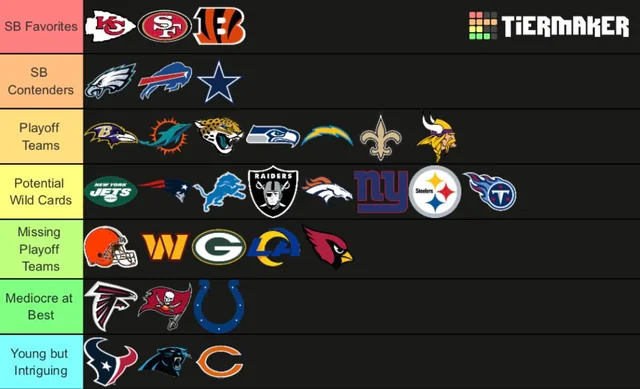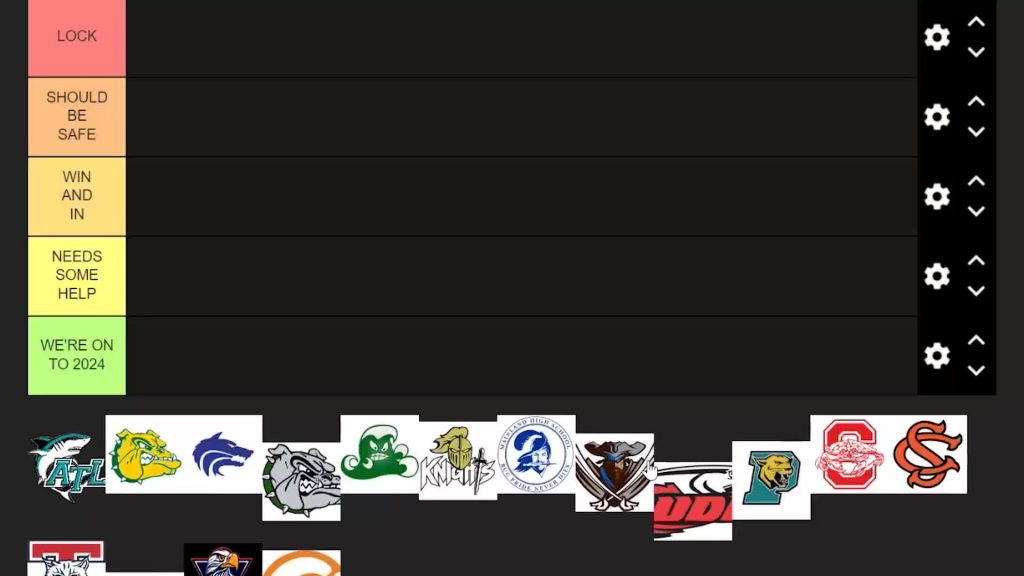As the current NFL season unfolds, fans’ and analysts’ excitement is palpable. Understanding the league dynamics is crucial, and tier lists have become essential in this endeavor. These lists categorize teams into different levels based on their performance, potential, and overall strength.

Today, we will break down NFL teams into a tiered ranking system, offering a forecast that highlights their prospects and challenges as the season progresses.
Understanding Tier Lists
A tier list in sports, particularly in the context of the NFL, is a nuanced and dynamic ranking system. It goes beyond mere standings by offering a more profound, multifaceted view of a team’s capabilities, tendencies, and potential. This system classifies teams into various levels based on multiple criteria, each of which is critical in determining their placement.
- Win-Loss Records: A team’s win-loss record is the most apparent and quantifiable metric. It provides a straightforward measure of a team’s performance but is just the starting point. A closer look at these records, including the quality of the opponents and the margins of victory or defeat, can offer more insights into the team’s true strength.
- Player Performances: Individual player performances are pivotal. Star quarterbacks, dominant wide receivers, resilient running backs, and impenetrable defensive players can significantly influence a game’s outcome. The tier list considers not just the star players but the depth of talent in the roster, including the contributions of less heralded players.
- Coaching Strategies: The impact of coaching cannot be overstated. A team’s strategy, adaptability, and in-game decision-making often reflect the coach’s vision and expertise. Coaches who can outmaneuver their counterparts or inspire their teams to overachieve can elevate a team’s tier ranking.
- Impact of Injuries: Injuries are an unfortunate but inevitable aspect of the game. Their effect on a team’s performance is considered in the tier list. The ability of a group to cope with critical injuries, adapt their playstyle, and maintain performance levels in the face of adversity is a testament to their depth and resilience.
- Team Chemistry and Momentum: Sports are not just about individual brilliance or tactical acumen but about how well players work together as a unit. Team chemistry can be a significant factor, particularly as the season progresses. Similarly, a team on a winning streak might be rated higher due to the positive momentum they carry.
- Historical Performance and Future Potential: While tier lists primarily focus on the current season, historical performance and future potential are also considered. Teams with a history of success in high-pressure situations or those demonstrating a clear upward trajectory can receive a favorable view.
- External Factors: Sometimes, external factors like changes in team management, player trades, or even fan support can influence a team’s performance. Though less quantifiable, these factors can have a substantial impact and are considered in nuanced tier assessments.
These rankings are not static but as dynamic as the sport itself. A team’s position on the tier list offers a snapshot of its current standing and potential trajectory as the season continues. It captures the essence of their journey, reflecting their past performances and hinting at their prospects.
👉 To stay updated on NFL matchups and team rankings, check out “Game On: Tracking NFL’s Weekly Matchup“.

Tier 1 Teams: The Contenders
The crème de la crème of the NFL, Tier 1 teams, consistently exhibit dominance on the field. This season, teams like the Kansas City Chiefs and the Tampa Bay Buccaneers have secured their spots at the top. Their success is attributed to elite quarterback play, innovative coaching, and overall team depth. The Chiefs, for instance, have showcased their offensive prowess, led by Patrick Mahomes’ exceptional skills. Meanwhile, the Buccaneers, under the leadership of Tom Brady, continue to demonstrate why experience is invaluable in high-stakes games. Their key victories against formidable opponents set them apart as the teams to beat.
Tier 2 Teams: The Challengers
Just a step below, Tier 2 teams possess the potential to disrupt the top echelons but haven’t quite reached that pinnacle. Teams like the Buffalo Bills and the Los Angeles Rams find themselves here. The Bills, with Josh Allen at the helm, have shown flashes of brilliance but need more consistency to break into the top tier. On the other hand, the Rams have struggled with maintaining their Super Bowl-winning form but have all the pieces needed to make a deep run. Their strengths lie in a solid defensive line, and a capable offense, but further cohesion and strategic finesse are required to elevate their game.
Tier 3 Teams: The Midfield
Tier 3 is where the majority of the teams lie. These teams, such as the Chicago Bears and the Carolina Panthers, display promising talent and frustrating inconsistency. For these teams, the focus is on building and refining their strategies. The Bears, for instance, are in a rebuilding phase, nurturing young talent like Justin Fields. The Panthers, dealing with injuries and some roster upheavals, still have the potential to surprise their opponents on any given Sunday. The key for these teams is to leverage their strengths and minimize weaknesses to climb the ranks.
Tier 4 Teams: The Underdogs
At the bottom of the list are the Tier 4 teams. These underdogs, including the New York Jets and the Jacksonville Jaguars, face significant challenges. They need help with issues ranging from inexperienced rosters to underperforming veterans. However, it’s not all doom and gloom. The Jets, for example, have a promising young core that could develop into a formidable force with time and the proper guidance. Similarly, the Jaguars, under new leadership, have the opportunity to rebuild and redefine their team identity.
Conclusion
As the season marches on, these tier rankings are likely to see some shifts. Injuries, trades, and the unpredictable nature of the game can quickly change a team’s fortune. For Tier 1 teams, the challenge will be to maintain their dominance, while those in Tier 2 will aim to break into the top tier. Midfield teams will seek consistency and growth, and the underdogs will look to upset the status quo and lay the groundwork for future success.

This dynamic assessment underscores the fluidity and unpredictability of the NFL. It reminds us that every game is a new chapter in a long, thrilling story. For fans and analysts alike, keeping a close eye on these tier lists provides a fascinating lens through which to view the season’s unfolding drama.



